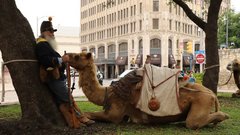Did you know that there was a time when camels were used by the U.S. Army at the Alamo?
Hundreds of visitors and children in Camp Alamo had the opportunity to get to know more about this forgotten part of Alamo history when the Texas Camel Corps stopped by on June 21.
”This is a forgotten part of Texas and Alamo history,” Alamo Education Specialist Machaia McClenny said. “People usually think about the Battle of the Alamo and go straight to modern day but there is a lot of history in between that we want to be able to share with visitors.”
Founded in 1997 by Doug Baum, the Texas Camel Corps visits sites with the goal of educating the public about the use of camels in America during the 19th century. This includes historic reenactments with live camels at schools, museums, libraries and historical sites like the Alamo. On June 21, Baum and his camels conducted public demonstrations of camel use in Alamo Plaza as well as private demos for our Camp Alamo participants.



